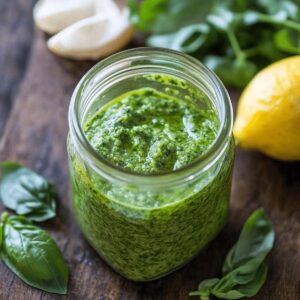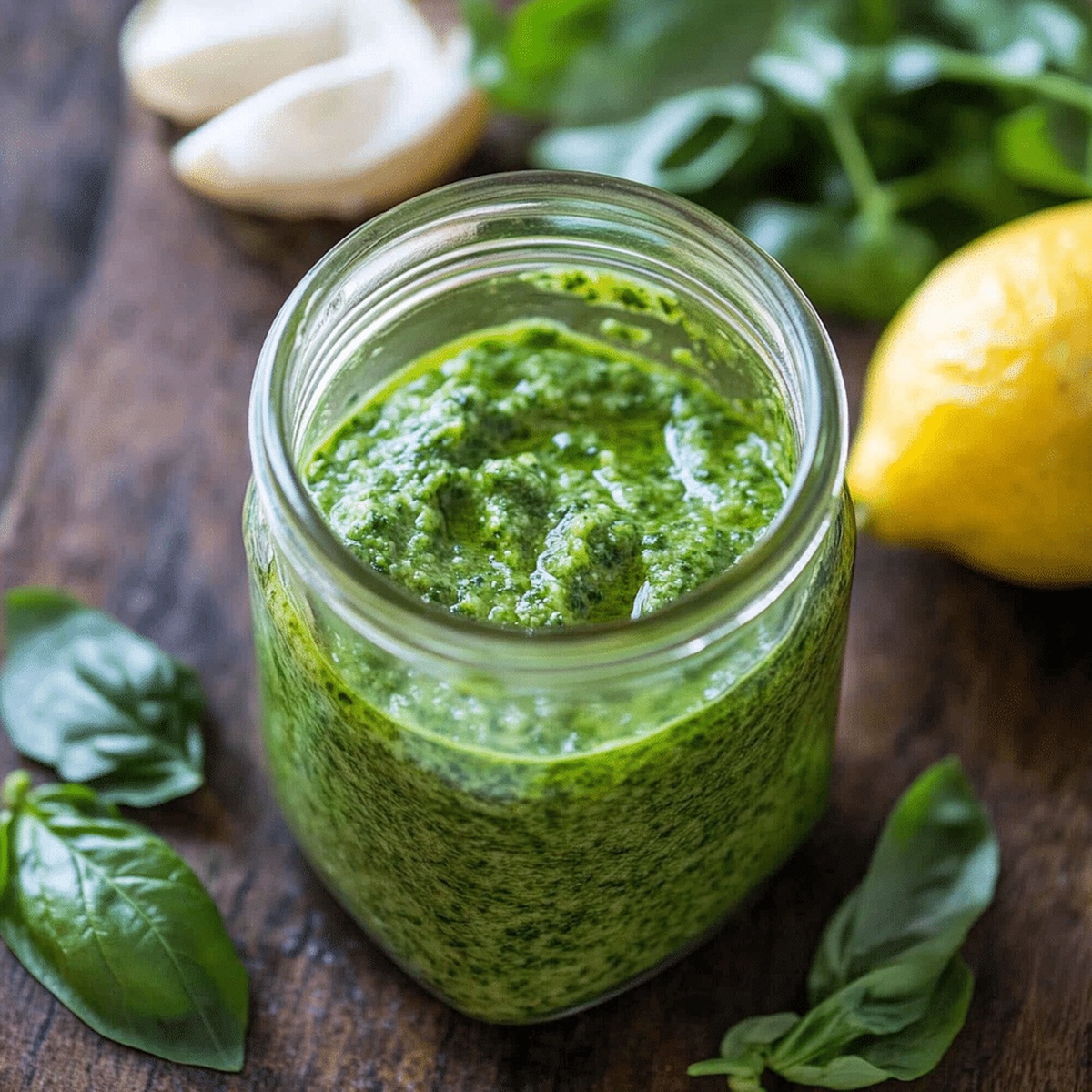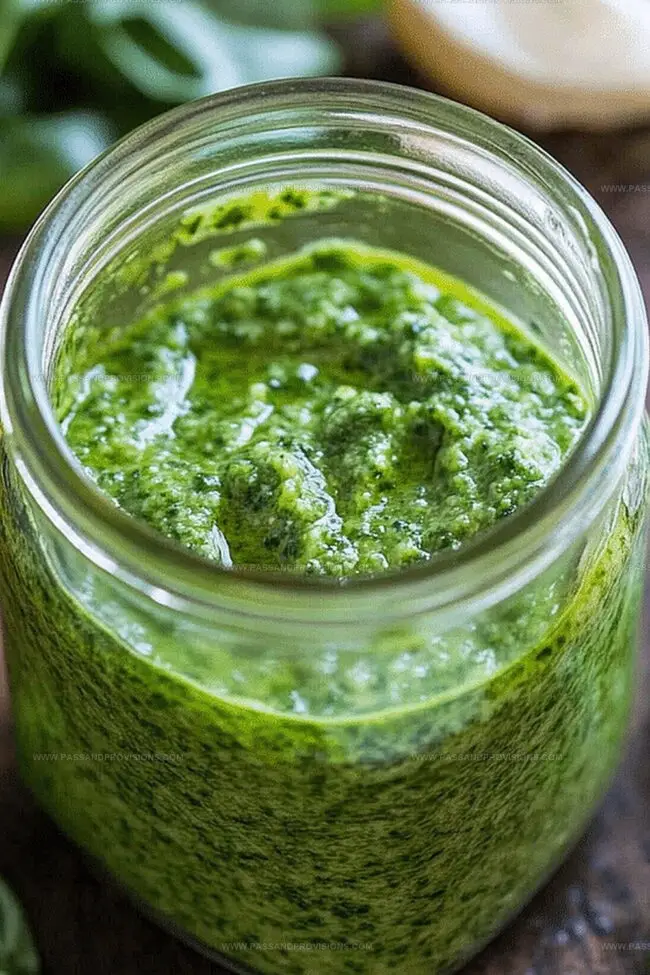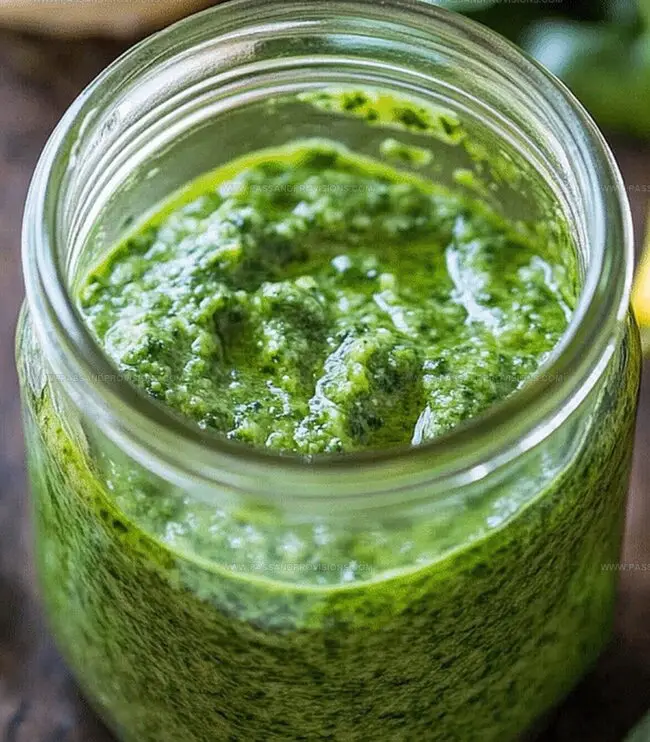Quick Homemade Pesto Recipe for Fresh Herb Magic
Crafting a vibrant pesto recipe brings pure culinary joy to your kitchen adventure.
Basil leaves dance with pine nuts in this classic Italian blend.
Fragrant garlic and sharp parmesan create magical harmony within each spoonful.
Grinding these ingredients transforms simple components into a luscious green sauce.
Mediterranean sunshine seems to burst through every dollop of this traditional preparation.
Creative cooks can personalize this recipe by swapping ingredients or adjusting proportions.
Let you explore this delightful sauce that promises to elevate any pasta, sandwich, or vegetable dish.
Pesto That’s Bold and Bright
Everything You Need for Homemade Pesto
Nuts:Base Ingredients:Cheese and Oil:Seasoning:How to Blend the Perfect Pesto Sauce
Step 1: Toast Pine Nuts
Place a dry skillet over medium heat. Add pine nuts and gently stir them around the pan. Watch for a golden color and a nutty fragrance developing, which typically takes 2-3 minutes. Once toasted, remove the skillet from heat and let the pine nuts cool completely.
Step 2: Prepare Fresh Ingredients
Gather these ingredients:Step 3: Blend Ingredients
Place toasted pine nuts, peeled garlic, and basil leaves into a food processor. Pulse the ingredients until they are roughly chopped.
Step 4: Create Smooth Texture
With the food processor running, slowly drizzle olive oil through the top opening. Continue blending until the mixture becomes smooth and well combined.
Step 5: Season Pesto
Add grated Parmesan cheese, salt, and black pepper to the processor. Pulse a few more times to integrate the seasonings evenly.
Step 6: Final Consistency Check
Taste the pesto and adjust seasonings as needed. If the texture seems too thick, add a little more olive oil and blend briefly.
Step 7: Store Pesto
Transfer the pesto to an airtight container. Pour a thin layer of olive oil on top to prevent browning. Refrigerate until ready to use.
Tips for Smooth, Balanced Flavor
Storing and Reheating Pesto
Best Dishes to Serve with Fresh Pesto
Variations That Put a Twist on Tradition
Pesto FAQs
Pine nuts are small, creamy edible seeds from pine trees. They provide a rich, buttery flavor and delicate texture that’s crucial to traditional pesto, adding nutty depth and smooth consistency to the sauce.
Absolutely! Walnuts, almonds, or sunflower seeds work great as pine nut alternatives. Each substitution will slightly change the flavor profile, but they’ll still create a delicious pesto sauce.
Look for a golden-brown color and watch for a fragrant, nutty aroma. They should smell warm and slightly sweet. Be careful not to burn them, as they can go from perfectly toasted to burnt quickly.
Yes, toasting brings out their natural oils and intensifies their nutty flavor. Raw pine nuts are more bland, while toasted nuts have a deeper, richer taste that enhances the overall pesto experience.
Print
Pesto Recipe
- Total Time: 10 minutes
- Yield: 4 1x
Description
Lush basil pesto brings Mediterranean sunshine to your kitchen, blending aromatic herbs with rich parmesan. Pine nuts and garlic create a classic Italian sauce that elevates pasta, sandwiches, and grilled dishes with irresistible flavor you’ll crave.
Ingredients
Main Ingredients:
- 2 cups (473 ml) fresh basil leaves, packed
- ⅓ cup (50 g) pine nuts
- ½ cup (50 g) grated Parmesan cheese
Aromatics and Seasonings:
- 2 garlic cloves
- ¼ teaspoon salt
- 1/8 teaspoon black pepper
Liquid Ingredient:
- ½ cup (118 ml) extra-virgin olive oil
Instructions
- Carefully warm an ungreased skillet over medium-high temperature, creating an even heating surface for toasting the pine nuts.
- Gently transfer pine nuts into the heated skillet, continuously moving them around to prevent burning and ensure uniform golden coloration.
- Listen for a subtle crackling sound and watch for a light golden hue, which signals the nuts are perfectly toasted and releasing their aromatic oils, approximately 2-3 minutes.
- Immediately remove the skillet from heat, allowing the pine nuts to cool naturally and prevent further browning.
- Transfer the toasted pine nuts to a separate cool surface, preparing them for the next stage of pesto preparation.
Notes
- Toast pine nuts carefully to enhance their nutty flavor without burning, watching them closely as they can quickly go from golden to charred.
- Swap pine nuts with more affordable alternatives like walnuts or almonds for budget-friendly pesto variations that still deliver rich, creamy texture.
- Use a food processor or high-powered blender to achieve smooth, well-integrated pesto with consistent texture and no large chunks of ingredients.
- Store fresh pesto in an airtight container with a thin layer of olive oil on top to prevent oxidation and maintain vibrant green color for up to a week in the refrigerator.
- Prep Time: 10 minutes
- Cook Time: 0 minutes
- Category: Lunch, Dinner, Snacks
- Method: Sautéing
- Cuisine: Italian
Nutrition
- Serving Size: 4
- Calories: 290
- Sugar: 1 g
- Sodium: 120 mg
- Fat: 28 g
- Saturated Fat: 4 g
- Unsaturated Fat: 24 g
- Trans Fat: 0 g
- Carbohydrates: 6 g
- Fiber: 1 g
- Protein: 7 g
- Cholesterol: 10 mg




Jamie Granger
Recipe Developer & Food Writer
Expertise
Education
Culinary Institute of America
Jamie Granger turns ingredients into memories. With her recipes, she brings a fusion-forward flair to every creation.
Her dishes reflect the places she’s explored, the chefs she’s learned from, and the deep connection she has to food as a form of expression.
At Pass and Provision, Jamie develops recipes that balance flavor, health, and beauty, meals that don’t just satisfy your appetite but speak to your curiosity.